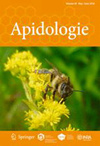Apidologie is a peer-reviewed journal devoted to the biology of insects belonging to the superfamily Apoidea.Its range of coverage includes behavior, ecology, pollination, genetics, physiology, systematics, toxicology and pathology. Also accepted are papers on the rearing, exploitation and practical use of Apoidea and their products, as far as they make a clear contribution to the understanding of bee biology.Apidologie is an official publication of the Institut National de la Recherche Agronomique (INRA) and Deutscher Imkerbund E.V. (D.I.B.)
Apidologie是一份同行评审期刊,致力于研究蜜蜂总科昆虫的生物学,涵盖范围包括行为学、生态学、授粉、遗传学、生理学、系统学、毒理学和病理学。此外,关于蜜蜂总科及其产品的饲养、开发和实际应用的论文也被接受,只要它们对蜜蜂生物学的理解做出了明确的贡献。 《蜜蜂学》是国家农业研究所(INRA )和德国工业联盟(D.I.B. )的官方出版物。
Bee colony losses in Brazil: a 5-year online survey
来源期刊:ApidologieDOI:10.1007/s13592-019-00642-7
Grooming behavior and gene expression of the Indiana “mite-biter” honey bee stock
来源期刊:ApidologieDOI:10.1007/s13592-019-00710-y
Sources and frequency of brood loss in solitary bees
来源期刊:ApidologieDOI:10.1007/s13592-019-00663-2
Low maize pollen collection and low pesticide risk to honey bees in heterogeneous agricultural landscapes
来源期刊:ApidologieDOI:10.1007/s13592-019-00655-2
Sublethal exposure to clothianidin during the larval stage causes long-term impairment of hygienic and foraging behaviours of honey bees
来源期刊:ApidologieDOI:10.1007/s13592-019-00672-1
Examining the nutritional value and effects of different floral resources in pumpkin agroecosystems on Bombus impatiens worker physiology
来源期刊:ApidologieDOI:10.1007/s13592-019-00668-x
Synergistic effects of three sterol biosynthesis inhibiting fungicides on the toxicity of a pyrethroid and neonicotinoid insecticide to bumble bees
来源期刊:ApidologieDOI:10.1007/s13592-019-00681-0
Factors affecting the reproductive health of honey bee (Apis mellifera) drones—a review
来源期刊:ApidologieDOI:10.1007/s13592-019-00684-x
Effects of Chlorella sp. on biological characteristics of the honey bee Apis mellifera
来源期刊:ApidologieDOI:10.1007/s13592-019-00670-3
Effect of chamber characteristics, incubation, and diluent on motility of honey bee (Apis mellifera) drone sperm
来源期刊:ApidologieDOI:10.1007/s13592-019-00659-y
Flight activity of honey bee (Apis mellifera) drones
来源期刊:ApidologieDOI:10.1007/s13592-019-00677-w
From the popular tRNAleu-COX2 intergenic region to the mitogenome: insights from diverse honey bee populations of Europe and North Africa
来源期刊:ApidologieDOI:10.1007/s13592-019-00632-9
2D-DIGE proteomic analysis reveals changes in haemolymph proteome of 1-day-old honey bee (Apis mellifera) workers in response to infection with Varroa destructor mites
来源期刊:ApidologieDOI:10.1007/s13592-019-00674-z
Temporal variation in homing ability of the neotropical stingless bee Scaptotrigona aff. postica (Hymenoptera: Apidae: Meliponini)
来源期刊:ApidologieDOI:10.1007/s13592-019-00682-z
Mitochondrial SNP markers to monitor evolutionary lineage ancestry in Apis melliferamellifera conservation programs
来源期刊:ApidologieDOI:10.1007/s13592-019-00666-z
The effect of conspecific cues on honey bee foraging behavior
来源期刊:ApidologieDOI:10.1007/s13592-019-00657-0
Wild bumble bee foraging preferences and fat content in highbush blueberry agro-ecosystems
来源期刊:ApidologieDOI:10.1007/s13592-019-00654-3
Brain composition and scaling in social bee species differing in body size
来源期刊:ApidologieDOI:10.1007/s13592-019-00685-w
Nosema ceranae infection enhances Bifidobacterium spp. abundances in the honey bee hindgut
来源期刊:ApidologieDOI:10.1007/s13592-019-00644-5
(S)-2-Heptanol, the alarm pheromone of the stingless bee Melipona solani (Hymenoptera, Meliponini)
来源期刊:ApidologieDOI:10.1007/s13592-019-00639-2
Hyperthermia treatment can kill immature and adult Varroa destructor mites without reducing drone fertility
来源期刊:ApidologieDOI:10.1007/s13592-019-00715-7
Pollen diet assessment and flower association in Melipona orbignyi and recommendations on management and conservation of stingless bees in the Chaco dry forest of South America
来源期刊:ApidologieDOI:10.1007/s13592-019-00653-4
Intranidal temperature and body size of Africanized honey bees under heatwaves (Hymenoptera: Apidae)
来源期刊:ApidologieDOI:10.1007/s13592-019-00725-5
Historical and contemporaneous human-mediated processes left a strong genetic signature on honey bee populations from the Macaronesian archipelago of the Azores
来源期刊:ApidologieDOI:10.1007/s13592-019-00720-w
Antibiotic treatment impairs protein digestion in the honeybee, Apis mellifera
来源期刊:ApidologieDOI:10.1007/s13592-019-00718-4
Radiofrequency identification (RFID) reveals long-distance flight and homing abilities of the stingless bee Melipona fasciculata
来源期刊:ApidologieDOI:10.1007/s13592-019-00706-8
The frequency of thelytokous parthenogenesis in European-derived Apis mellifera virgin queens
来源期刊:ApidologieDOI:10.1007/s13592-019-00649-0
Do rebel workers in the honeybee Apis mellifera avoid worker policing?
来源期刊:ApidologieDOI:10.1007/s13592-019-00689-6
Scientific note: cavity-nesting Osmia bruneri bees (Megachilidae) can use fruit pulp for nest construction
来源期刊:ApidologieDOI:10.1007/s13592-019-00634-7
Forage area estimation in European honeybees (Apis mellifera) by automatic waggle decoding of videos using a generic camcorder in field apiaries
来源期刊:ApidologieDOI:10.1007/s13592-019-00638-3
Recommendations for standardized oral toxicity test protocols for larvae of solitary bees, Osmia spp.
来源期刊:ApidologieDOI:10.1007/s13592-019-00704-w
Bioactivity of gallic acid–conjugated silica nanoparticles against Paenibacillus larvae and their host, Apis mellifera honeybee
来源期刊:ApidologieDOI:10.1007/s13592-019-00675-y
Neonicotinoids and fipronil concentrations in honeybees associated with pesticide use in Brazilian agricultural areas
来源期刊:ApidologieDOI:10.1007/s13592-019-00676-x
Pollinator effectiveness of a specialist bee exploiting a generalist plant—tracking pollen transfer by Heriades truncorum with quantum dots
来源期刊:ApidologieDOI:10.1007/s13592-019-00700-0
Parameters influencing queen body mass and their importance as determined by machine learning in honey bees (Apis mellifera carnica)
来源期刊:ApidologieDOI:10.1007/s13592-019-00683-y
Colombian stingless bee honeys characterized by multivariate analysis of physicochemical properties
来源期刊:ApidologieDOI:10.1007/s13592-019-00698-5
Development of a film-assisted honeybee egg collection system (FECS)
来源期刊:ApidologieDOI:10.1007/s13592-019-00687-8
Different activation of immune-related genes in honey bee nurses and foragers (Apis mellifera)
来源期刊:ApidologieDOI:10.1007/s13592-019-00658-z
Changes in the gene expression of chalkbrood resistance in Apis mellifera larvae infected by Ascosphaera apis
来源期刊:ApidologieDOI:10.1007/s13592-019-00702-y
Sperm competition in honey bees (Apis mellifera L.): the role of body size dimorphism in drones
来源期刊:ApidologieDOI:10.1007/s13592-019-00699-4
Effects of ensiling on the quality of protein supplements for honey bees Apis mellifera
来源期刊:ApidologieDOI:10.1007/s13592-019-00661-4
A genetic and morphological survey to trace the origin of Melipona beecheii (Apidae: Meliponini) from Cuba
来源期刊:ApidologieDOI:10.1007/s13592-019-00696-7
Choosing the best: honeybee workers can assess reproductive quality of the queen through pheromonal signalling in simultaneous choice assays
来源期刊:ApidologieDOI:10.1007/s13592-019-00712-w
Three-dimensional reconstruction of corpora allata nucleus reveals insights into epigenetic mechanisms of caste differentiation in Melipona scutellaris stingless bees
来源期刊:ApidologieDOI:10.1007/s13592-019-00647-2
Apis florea and Apis cerana workers do not discriminate between queen-laid and worker-laid Apis mellifera eggs
来源期刊:ApidologieDOI:10.1007/s13592-019-00678-9
Synergistic toxicity and physiological impact of thiamethoxam alone or in binary mixtures with three commonly used insecticides on honeybee
来源期刊:ApidologieDOI:10.1007/s13592-019-00726-4
Colour patterns, distribution and food plants of the Asian bumblebee Bombus bicoloratus (Hymenoptera: Apidae)
来源期刊:ApidologieDOI:10.1007/s13592-019-00648-1
Temporal drop of genetic diversity in Bombus pauloensis
来源期刊:ApidologieDOI:10.1007/s13592-019-00664-1
Rainfall, temperature, and vegetation type influence nesting by the oil-collecting bee Centris (Hemisiella) tarsata in Brazilian restinga
来源期刊:ApidologieDOI:10.1007/s13592-019-00688-7
Correction to: Apis mellifera hemocytes generate increased amounts of nitric oxide in response to wounding/encapsulation
来源期刊:ApidologieDOI:10.1007/s13592-019-00667-y




